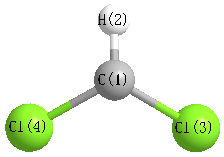Jump to
S1C2
Energy calculated at B2PLYP=FULL/6-31G
| | hartrees |
|---|
| Energy at 0K | -958.534782 |
| Energy at 298.15K | |
| HF Energy | -958.477326 |
| Nuclear repulsion energy | 120.763981 |
The energy at 298.15K was derived from the energy at 0K
and an integrated heat capacity that used the calculated vibrational frequencies.
Vibrational Frequencies calculated at B2PLYP=FULL/6-31G
| Mode Number |
Symmetry |
Frequency
(cm-1) |
Scaled Frequency
(cm-1) |
IR Intensities
(km mol-1) |
Raman Act
(Å4/u) |
Dep P |
Dep U |
|---|
| 1 |
A1 |
3350 |
3350 |
0.62 |
|
|
|
| 2 |
A1 |
685 |
685 |
13.55 |
|
|
|
| 3 |
A1 |
290 |
290 |
0.75 |
|
|
|
| 4 |
B1 |
427i |
427i |
88.55 |
|
|
|
| 5 |
B2 |
1241 |
1241 |
61.15 |
|
|
|
| 6 |
B2 |
854 |
854 |
149.48 |
|
|
|
Unscaled Zero Point Vibrational Energy (zpe) 2996.5 cm
-1
Scaled (by 1) Zero Point Vibrational Energy (zpe) 2996.5 cm
-1
See section
III.C.1 List or set vibrational scaling factors
to change the scale factors used here.
See section
III.C.2
Calculate a vibrational scaling factor for a given set of molecules
to determine the least squares best scaling factor.
Geometric Data calculated at B2PLYP=FULL/6-31G
Point Group is C2v
Cartesians (Å)
| Atom |
x (Å) |
y (Å) |
z (Å) |
|---|
| C1 |
0.000 |
0.000 |
0.705 |
| H2 |
0.000 |
0.000 |
1.781 |
| Cl3 |
0.000 |
1.538 |
-0.177 |
| Cl4 |
0.000 |
-1.538 |
-0.177 |
Atom - Atom Distances (Å)
| |
C1 |
H2 |
Cl3 |
Cl4 |
| C1 | | 1.0755 | 1.7733 | 1.7733 |
H2 | 1.0755 | | 2.4899 | 2.4899 | Cl3 | 1.7733 | 2.4899 | | 3.0765 | Cl4 | 1.7733 | 2.4899 | 3.0765 | |
 More geometry information
More geometry information
Calculated Bond Angles
| atom1 |
atom2 |
atom3 |
angle |
|
atom1 |
atom2 |
atom3 |
angle |
| Cl3 |
C1 |
H2 |
119.840 |
|
Cl3 |
C1 |
Cl4 |
120.321 |
| Cl4 |
C1 |
H2 |
119.840 |
|
Electronic energy levels
Charges, Dipole, Quadrupole and Polarizability
Jump to
S1C1
Energy calculated at B2PLYP=FULL/6-31G
| | hartrees |
|---|
| Energy at 0K | -958.536140 |
| Energy at 298.15K | -958.536888 |
| HF Energy | -958.478327 |
| Nuclear repulsion energy | 120.364175 |
The energy at 298.15K was derived from the energy at 0K
and an integrated heat capacity that used the calculated vibrational frequencies.
Vibrational Frequencies calculated at B2PLYP=FULL/6-31G
| Mode Number |
Symmetry |
Frequency
(cm-1) |
Scaled Frequency
(cm-1) |
IR Intensities
(km mol-1) |
Raman Act
(Å4/u) |
Dep P |
Dep U |
|---|
| 1 |
A' |
3297 |
3297 |
1.24 |
|
|
|
| 2 |
A' |
709 |
709 |
27.00 |
|
|
|
| 3 |
A' |
522 |
522 |
23.90 |
|
|
|
| 4 |
A' |
285 |
285 |
0.67 |
|
|
|
| 5 |
A" |
1252 |
1252 |
46.05 |
|
|
|
| 6 |
A" |
810 |
810 |
179.99 |
|
|
|
Unscaled Zero Point Vibrational Energy (zpe) 3437.7 cm
-1
Scaled (by 1) Zero Point Vibrational Energy (zpe) 3437.7 cm
-1
See section
III.C.1 List or set vibrational scaling factors
to change the scale factors used here.
See section
III.C.2
Calculate a vibrational scaling factor for a given set of molecules
to determine the least squares best scaling factor.
Geometric Data calculated at B2PLYP=FULL/6-31G
Point Group is Cs
Cartesians (Å)
| Atom |
x (Å) |
y (Å) |
z (Å) |
|---|
| C1 |
0.013 |
0.737 |
0.000 |
| H2 |
-0.535 |
1.667 |
0.000 |
| Cl3 |
0.013 |
-0.179 |
1.536 |
| Cl4 |
0.013 |
-0.179 |
-1.536 |
Atom - Atom Distances (Å)
| |
C1 |
H2 |
Cl3 |
Cl4 |
| C1 | | 1.0800 | 1.7887 | 1.7887 |
H2 | 1.0800 | | 2.4636 | 2.4636 | Cl3 | 1.7887 | 2.4636 | | 3.0730 | Cl4 | 1.7887 | 2.4636 | 3.0730 | |
 More geometry information
More geometry information
Calculated Bond Angles
| atom1 |
atom2 |
atom3 |
angle |
|
atom1 |
atom2 |
atom3 |
angle |
| Cl3 |
C1 |
H2 |
116.165 |
|
Cl3 |
C1 |
Cl4 |
118.413 |
| Cl4 |
C1 |
H2 |
116.165 |
|
Electronic energy levels
Charges, Dipole, Quadrupole and Polarizability
